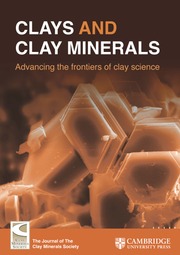Article contents
The Smectite-to-Disordered Kaolinite Transition in a Tropical Soil Chronosequence, Pacific Coast, Costa Rica
Published online by Cambridge University Press: 01 January 2024
Abstract
Soils developed on Quaternary fluvial fill terraces in the humid tropics of Costa Rica display progressive changes in mineral assemblage, chemical composition and particle size with age. Clay minerals from B horizons of active floodplains are predominantly smectite with lesser amounts of disordered kaolinite. B horizons in 5 to 10 ka soils consist of sub-equal amounts of smectite and disordered kaolinite, and soils on 37–125 ka terraces consist of disordered kaolinite with only traces of smectite. The composition of the smectite, as determined by EDX scans of smectite-rich pore space, is [(Mg0.2,Ca0.1)(Fe0.6Al1.4)(Si3.6Al0.4)O10(OH)2], consistent with ferruginous beidellite.
Bulk mineral assemblage varies from a smectite-plagioclase-augite-quartz-magnetite assemblage in ⩽ 10 ka terrace soils to a disordered kaolinite-goethite-hematite-quartz-magnetite assemblage in ⩾37 ka terrace soils. Leaching results in rapid loss of soluble base cations and residual concentration of Ti and Zr indicates mass losses of ∼50% by chemical denudation by 125 ka. Plots of terrace age vs. various measures of clay mineralogy, chemical composition, and particle size produce parabolic curves consistent with rapid chemical weathering pre-37 ka and slower to imperceptible rates of change from 37 to 125 ka. For some pedogenic properties, particularly particle size and concentrations of base cations and Zr, soils appear to reach steady-state conditions within 37 ka.
These results were applied to interpretation of landscape evolution in this tectonically active region by: (1) facilitating identification of two Holocene (5 ka and 10 ka) terraces on the Esterillos Block 5–30 m above sea level (masl), and two Pleistocene terraces ⩾ 125 ka on the Parrita Block 30 masl, and, in turn, (2) documenting uplift rates as high as 4.4 m/ka between 37 and 10 ka on the Esterillos Block, and as low as 0.1 m/ka over the past 125 ka on the adjacent Parrita Block. These findings are consistent with previous work indicating that the subduction of anomalous bathymetric features at the Middle America Trench is having a significant impact on fore-arc dynamics and topography over relatively short geological time periods and spatial scales.
Keywords
Information
- Type
- Research Article
- Information
- Copyright
- Copyright © 2006, The Clay Minerals Society
References
- 43
- Cited by

